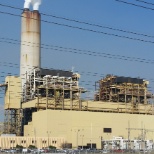Seminole Electric

Seminole Electric Headquarters Location
Tampa, FL
About Seminole Electric
Seminole Electric Cooperative is one of the largest generation and transmission (G&T) cooperatives in the country.
Seminole’s purpose is to provide safe, affordable, and reliable wholesale power to its nine Member distribution electric cooperatives.
Seminole’s primary resources include the Seminole Generating Station (SGS) in northeast Florida and the Richard J. Midulla Generating Station (MGS) in south central Florida. Approximately 1.8 million people and businesses in parts of 42 Florida counties rely on Seminole’s Member cooperatives for electricity. Seminole also owns and maintains more than 350 miles of transmission line.
HistorySeminole’s purpose is to provide safe, affordable, and reliable wholesale power to its nine Member distribution electric cooperatives.
Seminole’s primary resources include the Seminole Generating Station (SGS) in northeast Florida and the Richard J. Midulla Generating Station (MGS) in south central Florida. Approximately 1.8 million people and businesses in parts of 42 Florida counties rely on Seminole’s Member cooperatives for electricity. Seminole also owns and maintains more than 350 miles of transmission line.
In 1935, President Franklin D. Roosevelt created the Rural Electrification Administration (REA) by executive order to bring electricity to rural communities through the formation of electric cooperatives. In 1937, the REA drafted the Electric Cooperative Corporation Act, a law permitting states to create and operate not-for-profit, member-owned distribution electric cooperatives. The same year, Florida’s first distribution electric cooperatives were formed.
In 1948, Seminole Electric Cooperative was incorporated to give the Member distribution cooperatives buying power by aggregating their demand for electricity. Until the mid-1970s, Seminole remained a “paper G&T.”
However, the 1973 oil crisis prompted a decision by the Seminole Board to build its own coal-fired power plant – the Seminole Generating Station in Palatka, FL. The Seminole Generating Station came online in 1984.
Today, Seminole is one of the largest G&Ts in the country. Its purpose is to provide essential wholesale services to its nine Member distribution electric cooperatives.
Seminole’s primary resources include the Seminole Generating Station (SGS) in northeast Florida and the Richard J. Midulla Generating Station (MGS) in south central Florida. Seminole serves approximately 1.8 million people and businesses in parts of 42 Florida counties. Seminole also owns and maintains more than 350 miles of transmission line.
PurposeIn 1948, Seminole Electric Cooperative was incorporated to give the Member distribution cooperatives buying power by aggregating their demand for electricity. Until the mid-1970s, Seminole remained a “paper G&T.”
However, the 1973 oil crisis prompted a decision by the Seminole Board to build its own coal-fired power plant – the Seminole Generating Station in Palatka, FL. The Seminole Generating Station came online in 1984.
Today, Seminole is one of the largest G&Ts in the country. Its purpose is to provide essential wholesale services to its nine Member distribution electric cooperatives.
Seminole’s primary resources include the Seminole Generating Station (SGS) in northeast Florida and the Richard J. Midulla Generating Station (MGS) in south central Florida. Seminole serves approximately 1.8 million people and businesses in parts of 42 Florida counties. Seminole also owns and maintains more than 350 miles of transmission line.
What we do
Provide essential wholesale services to our Members through a balanced, diversified portfolio of safe, affordable, and reliable energy resources.
How we do it
With valuable employees who are adaptable, collaborative, conscientious, critical-thinking, outcome-driven, and professional.
What drives us
To be the preferred and trusted energy services provider empowering our Members and the communities we serve.
What we value
Accountability, integrity, and service rooted in the cooperative spirit.
PrinciplesProvide essential wholesale services to our Members through a balanced, diversified portfolio of safe, affordable, and reliable energy resources.
How we do it
With valuable employees who are adaptable, collaborative, conscientious, critical-thinking, outcome-driven, and professional.
What drives us
To be the preferred and trusted energy services provider empowering our Members and the communities we serve.
What we value
Accountability, integrity, and service rooted in the cooperative spirit.
Cooperatives, whether selling electricity or produce, share a common set of principles and values, including self-help and democracy. Known as the “Rochdale Principles,” they not only benefit the cooperatives, but the consumers as well. Introduced to the United States in 1874, the seven Rochdale Principles hold that a cooperative must provide:
1. VOLUNTARY AND OPEN MEMBERSHIP
Cooperatives are voluntary organizations, open to all persons able to use their services and willing to accept the responsibilities of membership, without gender, social, racial, political or religious discrimination.
2. DEMOCRATIC MEMBER CONTROL
Cooperatives are democratic organizations controlled by their members, who actively participate in setting policies and making decisions. The elected representatives are accountable to the membership. In primary cooperatives, members have equal voting rights (one member, one vote) and cooperatives at other levels are organized in a democratic manner.
3. MEMBERS’ ECONOMIC PARTICIPATION
Members contribute equitably to, and democratically control, the capital of their cooperative. At least part of that capital is usually the common property of the cooperative. Members usually receive limited compensation, if any, on capital subscribed as a condition of membership. Members allocate surpluses for any or all of the following purposes: developing the cooperative, possibly by setting up reserves, part of which at least would be indivisible; benefitting members in proportion to their transactions with the cooperative; and supporting other activities approved by the membership.
4. AUTONOMY AND INDEPENDENCE
Cooperatives are autonomous, self-help organizations controlled by their members. If they enter into agreements with other organizations, including governments, or raise capital from external sources, they do so on terms that ensure democratic control by their members and maintain their cooperative autonomy.
5. EDUCATION, TRAINING, AND INFORMATION
Cooperatives provide education and training for their members, elected representatives, managers and employees so they can contribute effectively to the development of their cooperatives. They inform the general public, particularly young people and opinion leaders, about the nature and benefits of cooperation.
6. COOPERATION AMONG COOPERATIVES
By working together through local, national, regional, and international structures, cooperatives improve services, bolster local economies, and deal more effectively with social and community needs.
7. CONCERN FOR COMMUNITY
While focusing on member needs, cooperatives work for the sustainable development of their communities through policies accepted by their members.
Careers1. VOLUNTARY AND OPEN MEMBERSHIP
Cooperatives are voluntary organizations, open to all persons able to use their services and willing to accept the responsibilities of membership, without gender, social, racial, political or religious discrimination.
2. DEMOCRATIC MEMBER CONTROL
Cooperatives are democratic organizations controlled by their members, who actively participate in setting policies and making decisions. The elected representatives are accountable to the membership. In primary cooperatives, members have equal voting rights (one member, one vote) and cooperatives at other levels are organized in a democratic manner.
3. MEMBERS’ ECONOMIC PARTICIPATION
Members contribute equitably to, and democratically control, the capital of their cooperative. At least part of that capital is usually the common property of the cooperative. Members usually receive limited compensation, if any, on capital subscribed as a condition of membership. Members allocate surpluses for any or all of the following purposes: developing the cooperative, possibly by setting up reserves, part of which at least would be indivisible; benefitting members in proportion to their transactions with the cooperative; and supporting other activities approved by the membership.
4. AUTONOMY AND INDEPENDENCE
Cooperatives are autonomous, self-help organizations controlled by their members. If they enter into agreements with other organizations, including governments, or raise capital from external sources, they do so on terms that ensure democratic control by their members and maintain their cooperative autonomy.
5. EDUCATION, TRAINING, AND INFORMATION
Cooperatives provide education and training for their members, elected representatives, managers and employees so they can contribute effectively to the development of their cooperatives. They inform the general public, particularly young people and opinion leaders, about the nature and benefits of cooperation.
6. COOPERATION AMONG COOPERATIVES
By working together through local, national, regional, and international structures, cooperatives improve services, bolster local economies, and deal more effectively with social and community needs.
7. CONCERN FOR COMMUNITY
While focusing on member needs, cooperatives work for the sustainable development of their communities through policies accepted by their members.
As one of the nation’s largest Generation and Transmission (G&T) cooperatives, our reach extends to more than 1.8 million people and businesses across the great state of Florida. Our winning team of skilled professionals is what makes our success possible. From networking, outreach, and planning to finance, maintenance, and education, Seminole Electric Cooperative has a diverse number of career paths for professionals with a wide variety of skill sets, goals, and interests.
As our organization continues to expand, we are always on the lookout for top talent to join our growing professional family. If you’re ready for an electrifying career with tremendous potential for success, we invite you to explore our exciting opportunities.
BenefitsAs our organization continues to expand, we are always on the lookout for top talent to join our growing professional family. If you’re ready for an electrifying career with tremendous potential for success, we invite you to explore our exciting opportunities.
Seminole Electric Cooperative believes in creating a culture that gives back to our people, both professionally and personally. We offer an outstanding benefits package that includes:
-Generous vacation package
-30 minutes from the beaches
-Comprehensive health plans
-Wellness incentive program
-Gym membership reimbursement
-Free on site gym and fitness classes
-Pension plan
-401(k) employer match
-Tuition reimbursement
-Training and Development
-Paid parental leave
-And much more!
It’s time to jump start your success – join the Seminole Electric Cooperative today!
-Generous vacation package
-30 minutes from the beaches
-Comprehensive health plans
-Wellness incentive program
-Gym membership reimbursement
-Free on site gym and fitness classes
-Pension plan
-401(k) employer match
-Tuition reimbursement
-Training and Development
-Paid parental leave
-And much more!
It’s time to jump start your success – join the Seminole Electric Cooperative today!
Number of Employees in Seminole Electric
201 to 500
Seminole Electric Revenue
$1B to $5B (USD)
Industry

